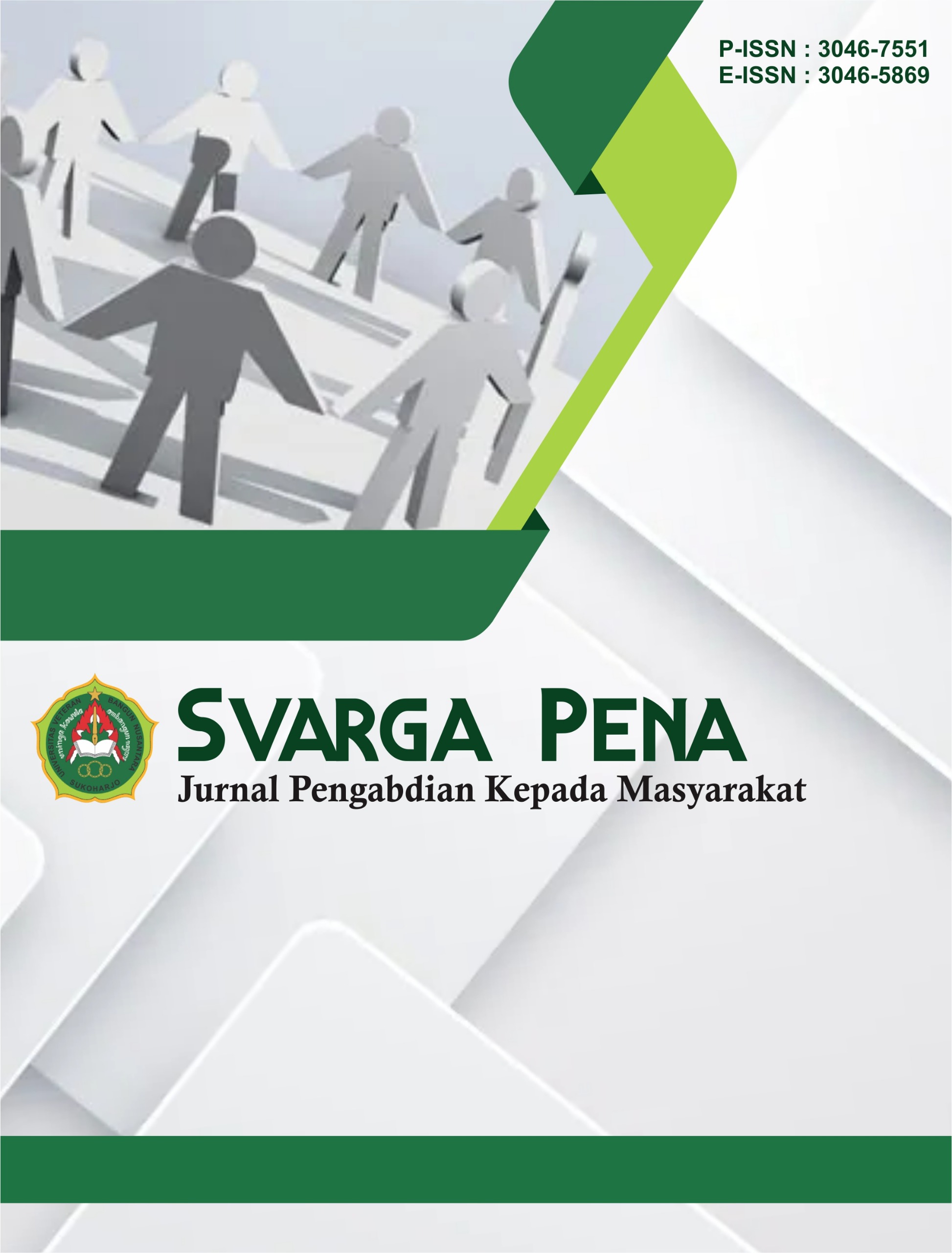Pemanfaatan Limbah Sagu Menjadi Biochar bagi Masyarakat di Negeri Seruawan, Seram Bagian Barat
DOI:
https://doi.org/10.62951/svargapena.v2i1.115Keywords:
Biochar, Sago, Seruawan, WasteAbstract
Sago waste is a significant environmental problem in sago-producing areas, including Seruawan Village. This waste is often burned or simply dumped, which has the potential to cause environmental pollution and reduce soil quality. Therefore, the utilization of sago waste into biochar can be a sustainable and environmentally friendly solution. Biochar is a carbon product resulting from the pyrolysis process of organic matter, which can improve soil fertility and reduce greenhouse gas emissions. By utilizing sago waste into biochar, the community in Seruawan Village can not only reduce waste, but also increase their agricultural productivity. The methodology used is through observation, interviews, technology utilization, and participatory action research. Through a systematic and participatory methodology, this service is expected to make a significant contribution to the management of sago waste into biochar, and improve the welfare of the community in Seruawan Village.
References
Chan, K. Y., Xu, Z., & Liu, W. (2008). Biochar improves soil fertility and crop yield in a low-input agricultural system. Soil Use and Management, 24(4), 303-309.
Herdiyanto, D. D., & Setiawan, A. (2015). Upaya peningkatan kualitas tanah melalui sosialisasi pupuk hayati, pupuk organik, dan olah tanah konservasi di Desa Sukamanah dan Desa Nanggerang Kecamatan Cigalontang Kabupaten Tasikmalaya. Dharmakarya: Jurnal Aplikasi Ipteks Untuk Masyarakat, 4(1).
Hukubun, R. D., Paulus, J. M., Nustelu, J., Ayuasthika, V., Kufla, Y. J., Huwae, L. M. C., & Huwae, L. B. S. (2024). Sosialisasi perilaku hidup bersih dan sehat di Sekolah Dasar Negeri Naku. Alkhidmah: Jurnal Pengabdian dan Kemitraan Masyarakat, 2(1), 08-17.
Lehmann, J., & Joseph, S. (2015). Biochar for Environmental Management: Science, Technology and Implementation. Routledge.
Makahity, A., Rurum, W., Nikijuluw, M. M., Kendy, I., & Hukubun, R. D. (2022). Peningkatan ekonomi masyarakat melalui pelatihan pemanfaatan handuk bekas sebagai produk kerajinan tangan. Empowerment: Jurnal Pengabdian Masyarakat, 1(3), 415-420.
Mulyadi, A., Supriyadi, & Hidayat, A. (2019). Pemanfaatan limbah sagu sebagai bahan baku biochar. Jurnal Teknologi Pertanian, 20(2), 45-52.
Sarwono, R. (2016). Biochar sebagai penyimpan karbon, perbaikan sifat tanah, dan mencegah pemanasan global: Tinjauan. Jurnal Kimia Terapan Indonesia, 18(01), 79-90.
Suhartawan, B., Suprihatin, H., Hammado, N., Yuniarti, E., Suyasa, W. B., Asnawi, I., & Toepak, E. P. (2023). Pengelolaan limbah padat, limbah industri dan B3. Padang: Get Press Indonesia.
Sujana, I. P. (2015). Pengelolaan tanah ultisol dengan pemberian pembenah organik biochar menuju pertanian berkelanjutan. Agrimeta, 5(09), 89640.
Tjokrodiningrat, S., Sapsuha, Y., & Abdullatif, Z. (2023). Aplikasi biosaka dan biochar pada lahan tanaman hortikultura di Pulau Ternate. Jurnal Pengabdian Masyarakat Hutan, 1(2), 31-40.
Additional references:
Smith, J. R., & Lee, T. (2022). The role of biochar in sustainable agriculture practices. Journal of Environmental Sustainability, 9(3), 234-242.
Tan, H. C., & Ng, M. (2018). Environmental benefits of biochar application in tropical soils. Environmental Science and Pollution Research, 25(5), 4872-4881.
Williams, S. E., & Liu, Z. (2019). The effects of biochar on soil organic carbon and nitrogen cycling in agricultural systems. Soil Science and Plant Nutrition, 65(4), 480-488.
Yuan, J., & Xu, Y. (2020). Biochar application in agriculture: Effects on soil properties and crop production. Agricultural Science Journal, 10(2), 101-109.
Zhang, Y., & Li, Z. (2021). Long-term effects of biochar on soil fertility and crop yield in a low-carbon agriculture system. Environmental Research Letters, 16(7), 045034.
Downloads
Published
How to Cite
Issue
Section
License
Copyright (c) 2025 Svarga Pena : Jurnal Pengabdian Kepada Masyarakat

This work is licensed under a Creative Commons Attribution-ShareAlike 4.0 International License.













